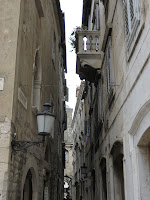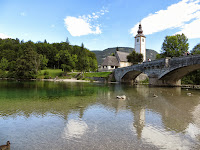Athens airport has improved a lot from 20 years ago when it was a dump; it is modern with many facilities as well as buses and trains that go to the centre of the city. Well, I suppose with the Olympic Games in 2004 helped to smarten things up.
We arrived at 9.30 pm as our plane was delayed and by the time we retrieved our luggage and made it to the transport options it was getting late. By the time we hit the city centre it was dark. We had the address of our hotel which I knew wasn’t far from the bus stop, the only problem was orientating the direction I needed to go as I didn’t have a great map. I finally went into a large hotel to get directions and was at least pointed in the right direction, though they didn’t have a free map to give me, which was unusual.
We walked in the given direction, received some reassurance from a person in a money exchange booth, but were still baffled as we couldn’t seem to find the street we needed. Two para-military were standing by their bus. I asked them directions, showed them the address I needed, which was very dark and therefore hard to read. ‘Have you got a torch?’ I asked. One produced it with a smile waved it around then proceeded to scrutinize the address after a short discussion amongst themselves, they gave us very precise directions and we found our hotel without hitch after that.
We were thankful to get to our room, drop our luggage and find something to eat, across the road from out hotel there was a small restaurant, we shared a pizza, boring, yes, but it was light and just enough. We then went back to our room and planned the next day.
We were up early, ready to make our way to the Acropolis, it’s easy to find as it can be seen from anywhere and you just walk in its general direction and eventually you will find signs pointing the way. We arrived at a reasonable time in the morning and it wasn’t so crowded. It is wonderful walking around
 |
| The Acropolis |
We walked around the outside and popped into the tiny Church of Metamorphosis then wandered down through the Agora which is quite expansive. It was the centre of political and public life. It has a large open area which is surrounded by buildings which were used for commerce, political, cultural and the military life. Walking around this area it’s not hard to imagine the life in ancient Greece, people going about their everyday business, shopping, chatting and sitting around watching the passing parade. Maybe they even dropped into Hadrian’s library on their way home.
 |
| The Agora |
By the time we had finished walking around we were hot, tired and hungry. We then made our way to a line of restaurants next to the Agora. It was not hard to find a place to eat and we had an enjoyable lunch and relaxed a little.
Then back on our feet through the Flea Market, with its very trashy products. After all our walking we went back to our hotel for a little siesta. Then we decide to go to the Plaka for dinner. Not surprising this has also changed heaps in 20 years. It used to be a lot more low key. Still with plenty of restaurants and jewellery shops, but I think they had better jewellery then. It’s much more commercial now. We met an English couple with whom we had a good conversation and ended up eating at the restaurant they were sitting at. We had a lovely meal. I think most places in this area all serve much the same fare, but some are more pricey and pushy then others.
The following day we went to the Museum of the University of Athens, which is situated in the building that functioned as the first university of the Independent Greek State from 1837-41. The collections at the museum include books (works by the University’s Professors), manuscripts, documents, photographs etc. The collections are divided into the University’s first schools (Medicine, Law, Philosophy and Theology). The collections are very interesting and worth a visit, a bonus is that you get a magnificent view of Athens from the balcony.
We then decided to go to the Gallery of Modern Greek Art. It is always interesting to visit galleries and see different artistic interpretations from other countries. First we had to hunt the Gallery as the original building was being renovated; the whole exercise was a bit of an expedition. We finally located it and spent some time there but our overall feeling was that it was a bit disappointing, there was no painting or artist we felt really stood out. As we had spent most of the time finding the gallery along the less touristy area, passed closed shops, run- down buildings and a whole lot of second hand shops selling a lot of junk really, it threw into view how the economic problems of Greece has affected so many. We had dinner at the Plaka again that night, though touristy, it’s a nice area and close to where we are staying and have many restaurants to choose from.
We planned to go to Lykavittόs Hill which rises 277metres above the city. We were lazy and took the funicular; it can about 45 minutes to climb it on foot. We had a great view. The downside was that
 |
| Athens from Lykavitoos Hill |
However as we were coming back down from the funicular we came across a Friday market which we enjoyed looking at the various produce. Then as we made our way down we found this little café and had a very nice lunch at a reasonable price.
As we were making our way back we were near the Byzantium Museum is located in a beautiful Florentine style villa. It has an extensive collection which is divided into two sections, Section 1: From the Ancient World to Byzantium, which traces the rise of Christianity and Section 2: The Byzantium World runs from the 6th century to the fall of Constantinople in 1453. It is all very informative and gives a good historical overview with an interesting array of exhibits. It was well worth a visit.
 |
| Monastery of Dafni |
We were helped to get the correct bus and one of the passengers was determined to make sure we found the ancient ruins and instructed us to follow him. The ancient site was fascinating to walk around. For 1,400 years Eleusis was the centre of a religious cult that culminated in an annual Eleusinian Mysteries festival. Eleusis was closed by the Romans in AD 369.
 |
| Ruins of Ancient Eleusis |
Just opposite the site was a delightful restaurant where we had lunch and then made our way back to the bus stop to return to Athens proper.
The following day we were leaving for Napoli on the Peloponnese.































